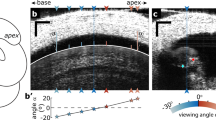Abstract
The contribution of human ear canal orientation to tympanic membrane (TM) surface motion and sound pressure distribution near the TM surface is investigated by using an artificial ear canal (aEC) similar in dimensions to the natural human ear canal. The aEC replaced the bony ear canal of cadaveric human temporal bones. The radial orientation of the aEC relative to the manubrium of the TM was varied. Tones of 0.2 to 18.4 kHz delivered through the aEC induced surface motions of the TM that were quantified using stroboscopic holography; the distribution of sound in the plane of the tympanic ring P TR was measured with a probe tube microphone. The results suggest that the ear canal orientation has no substantial effect on TM surface motions, but P TR at frequencies above 10 kHz is influenced by the ear canal orientation. The complex TM surface motion patterns observed at frequencies above a few kilohertz are not correlated with simpler variations in P TR distribution at the same frequencies, suggesting that the complex sound-induced TM motions are more related to the TM mechanical properties, shape, and boundary conditions rather than to spatial variations in the acoustic stimulus.











Similar content being viewed by others
References
Chan TF, Vese LA (2001) Active contour without edges. IEEE Trans Image Proc 10(2):266–277
Cheng JT, Aarnisalo AA, Harrington E, Hernández-Montes MS, Furlong C, Merchant SN, Rosowski JJ (2010) Motion of the surface of the human tympanic membrane measured with stroboscopic holography. Hear Res 263:66–77
Cheng JT, Hamade M, Harrington E, Furlong C, Merchant SN, Rosowski JJ (2013) Wave motion on the surface of the human tympanic membrane: holographic measurement and modeling analysis. J Acoust Soc Am 133(2):918–37
DiMaio FHP, Tonndorf J (1978) The terminal zone of the external auditory meatus in a variety of mammals. Arch Otolaryngol 104:570–575
Fletcher NH (1992) Acoustic systems in biology. Oxford University Press, New York
Gan RZ, Wood MW, Dormer KJ (2004) Human middle-ear transfer function measured by double laser interferometry system. Otol Neurotol 25:423–435
Goode RL, Ball G, Nishihara S (1993) Measurement of umbo vibration in human subjects-methods and possible clinical applications. Am J Otol 14:247–251
Guignard J, Cheng JT, Ravicz ME, Rosowski JJ (2014) Aligning digital holography images of tympanic membrane motion. Proc Meetings Acoustics 21:050003
Haralick RM, Shapiro LG (1992) Computer and robot vision, 1st edn. Addison-Wesley Longman Publishing Co., Inc, Boston
Hato N, Stenfelt S, Goode RL (2003) Three-dimensional stapes footplate motion in human temporal bones. Audiol Neurootol 8:140–152
Holte LA (1989) Longitudinal tympanometry and pneumatic otoscopy in healthy newborn infants. Doctoral dissertation, Syracuse University
Kinsler LE, Frey AR, Coppens AB, Sanders JV (1982) Fundamentals of acoustics. John Wiley & Sons, New York
Nakajima HH, Ravicz ME, Rosowski JJ, Peake WT, Merchant SN (2005) Experimental and clinical studies of malleus fixation. Laryngoscope 115:147–154
Nakajima HH, Dong W, Olson ES, Merchant SN, Ravicz ME, Rosowski JJ (2009) Differential introcochlear sound pressure measurements in normal human temporal bones. J Assoc Res Otolaryngol 10:23–36
O’Connor KN, Puria S (2008) Middle-ear circuit model parameters based on a population of human ears. J Acoust Soc Am 123(1):197–211
Parent P, Allen JB (2007) Wave model of the cat tympanic membrane. J Acoust Soc Am 122:918–931
Parent P, Allen JB (2010) Time-domain wave model of the human tympanic membrane. Hear Res 263:152–167
Ravicz ME, Olson ES, Rosowski JJ (2007) Sound pressure distribution and energy flow within the gerbil ear canal from 100 Hz to 80 kHz. J Acoust Soc Am 122:2154–2173
Ravicz ME, Cheng JT, Rosowski JJ (2014) Sound pressure distribution within the human ear canal and models: forward stimulation. J Acoust Soc Am 136(6):3132–3146
Rosowski JJ, Cheng JT, Ravicz ME, Hulli N, Harrington EJ, Hernández-Montes M dS, Furlong C (2009) Computer-assisted time-averaged holography of the motion of the surface of the tympanic membrane with sound stimuli of 0.4 to 25 kHz. Hear Res 253:83–96
Rosowski JJ, Cheng JT, Merchant SN, Harrington E, Furlong C (2011) New data on the motion of the normal and reconstructed tympanic membrane. Otol Neurotol 32:1559–1567
Shaw EAG (1974) The external ear. In: Keidel WD, Neff WD (eds) Handbook of sensory physiology: vol V/1: auditory system. Springer-Verlag, New York, pp 455–490
Stinson MR (1985) The spatial distribution of sound pressure within scaled replicas of the human ear. J Acoust Soc Am 78:1596–1602
Stinson MR, Khanna SM (1989) Sound propagation in the ear canal and coupling to the eardrum, with measurements on model systems. J Acoust Soc Am 85:2481–2491
Tonndorf J, Khanna SM (1970) The role of the tympanic membrane in middle-ear transmission. Ann Otol 79:743–753
Van der Jeught S, Dirckx JJJ, Aerts JRM, Bradu A, Podoleanu AG, Buytaert JAN (2013) Full-field thickness distribution of human tympanic membrane obtained with optical coherence tomography. JARO 14:483–494
Wolberg G, Zokai S (2000) Robust image registration using log-Polar transform. Proc of IEEE Intl Conf on Image Proc 1:493–496
Acknowledgments
The authors thank Diane Jones at the Eaton-Peabody Laboratory (EPL) of the Massachusetts Eye and Ear Infirmary (MEEI) for help in acquiring temporal bone specimens. Ivo Dobrev and Morteza Khaleghi from the Center for Holographic Studies and Laser Micro-mechaTronics (CHSLT) at the Worcester Polytechnic Institute (WPI) have provided technical assistances in the use of the Holographic Interferometry system. Nima Maftoon and Melissa McKinnon from MEEI for commenting on the manuscript. This work was supported by NRSA 1F32DC009949-01, 1R03DC011617-01, and R01-DC008642 from NIDCD and a donation from L. Mittal. JG was funded by the Swiss National Science Foundation (SNSF).
Author information
Authors and Affiliations
Corresponding author
Rights and permissions
About this article
Cite this article
Cheng, J.T., Ravicz, M., Guignard, J. et al. The Effect of Ear Canal Orientation on Tympanic Membrane Motion and the Sound Field Near the Tympanic Membrane. JARO 16, 413–432 (2015). https://doi.org/10.1007/s10162-015-0516-x
Received:
Accepted:
Published:
Issue Date:
DOI: https://doi.org/10.1007/s10162-015-0516-x




